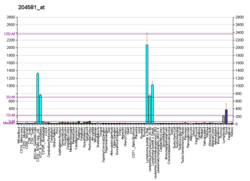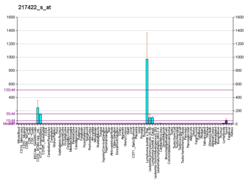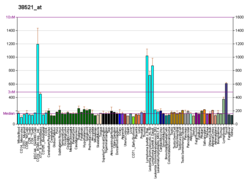CD22
CD22, hay cụm biệt hóa-22, là một phân tử thuộc họ SIGLEC của lectin.[2] Nó được tìm thấy trên bề mặt của các tế bào B trưởng thành và biểu hiện với mức độ thấp hơn ở một số tế bào B chưa trưởng thành. Nói chung, CD22 là một phân tử điều hòa ngăn chặn sự hoạt động quá mức của hệ miễn dịch và sự phát triển của các bệnh tự miễn.[3]
CD22 là một protein xuyên màng liên kết với đường, đặc biệt là liên kết với axit sialic với một miền immunoglobulin (Ig) nằm ở đầu tận cùng N của nó. Sự hiện diện của các miền Ig làm cho CD22 trở thành một thành viên của siêu họ immunoglobulin. CD22 hoạt động như một thụ thể ức chế tín hiệu từ thụ thể tế bào B (BCR). CD22 cũng tham gia vào việc di chuyển tế bào B vào các phiến Peyer (màng nhầy dịch vị đặt trung của ruột) ở chuột.[4]
Một độc tố miễn dịch, BL22, nhắm vào thụ thể này đang được thử nghiệm tại Viện Y tế Quốc gia ở Mỹ.[5]
Tương tác
[sửa | sửa mã nguồn]CD22 đã được cho thấy là tương tác với Grb2,[6][7] PTPN6,[7][8][9][10][11] LYN,[6][9] SHC1[6] and INPP5D.[6]
Chú thích
[sửa | sửa mã nguồn]- ^ “Human PubMed Reference:”.
- ^ Crocker PR, và đồng nghiệp (tháng 2 năm 1998). “Siglecs: a family of sialic-acid binding lectins”. Glycobiology. 8 (2): v. doi:10.1093/glycob/8.2.0. PMID 9498912.
- ^ Hatta; và đồng nghiệp (1999). “Identification of the gene variations in human CD22”. Immunogenetics. 49 (4): 280–286. doi:10.1007/s002510050494. Bản gốc lưu trữ ngày 24 tháng 9 năm 2019. Truy cập ngày 16 tháng 6 năm 2018.
- ^ Lee M, Kiefel H, LaJevic MD, Macauley MS, Kawashima H, O'Hara E, Pan J, Paulson JC, Butcher EC (tháng 10 năm 2014). “Transcriptional programs of lymphoid tissue capillary and high endothelium reveal control mechanisms for lymphocyte homing”. Nature Immunology. 15 (10): 982–95. doi:10.1038/ni.2983. PMC 4222088. PMID 25173345.
- ^ “BL22 Immunotoxin in Treating Patients Previously Treated With Cladribine for Hairy Cell Leukemia”. ClinicalTrials.gov - U.S. National Institutes of Health. Truy cập ngày 19 tháng 2 năm 2008.
- ^ a b c d Poe JC, Fujimoto M, Jansen PJ, Miller AS, Tedder TF (tháng 6 năm 2000). “CD22 forms a quaternary complex with SHIP, Grb2, and Shc. A pathway for regulation of B lymphocyte antigen receptor-induced calcium flux”. The Journal of Biological Chemistry. 275 (23): 17420–7. doi:10.1074/jbc.M001892200. PMID 10748054.
- ^ a b Otipoby KL, Draves KE, Clark EA (tháng 11 năm 2001). “CD22 regulates B cell receptor-mediated signals via two domains that independently recruit Grb2 and SHP-1”. The Journal of Biological Chemistry. 276 (47): 44315–22. doi:10.1074/jbc.M105446200. PMID 11551923.
- ^ Blasioli J, Paust S, Thomas ML (tháng 1 năm 1999). “Definition of the sites of interaction between the protein tyrosine phosphatase SHP-1 and CD22”. The Journal of Biological Chemistry. 274 (4): 2303–7. doi:10.1074/jbc.274.4.2303. PMID 9890995.
- ^ a b Greer SF, Justement LB (tháng 5 năm 1999). “CD45 regulates tyrosine phosphorylation of CD22 and its association with the protein tyrosine phosphatase SHP-1”. Journal of Immunology. 162 (9): 5278–86. PMID 10228003.
- ^ Law CL, Sidorenko SP, Chandran KA, Zhao Z, Shen SH, Fischer EH, Clark EA (tháng 2 năm 1996). “CD22 associates with protein tyrosine phosphatase 1C, Syk, and phospholipase C-gamma(1) upon B cell activation”. The Journal of Experimental Medicine. 183 (2): 547–60. doi:10.1084/jem.183.2.547. PMC 2192439. PMID 8627166.
- ^ Adachi T, Wienands J, Wakabayashi C, Yakura H, Reth M, Tsubata T (tháng 7 năm 2001). “SHP-1 requires inhibitory co-receptors to down-modulate B cell antigen receptor-mediated phosphorylation of cellular substrates”. The Journal of Biological Chemistry. 276 (28): 26648–55. doi:10.1074/jbc.M100997200. PMID 11356834.


